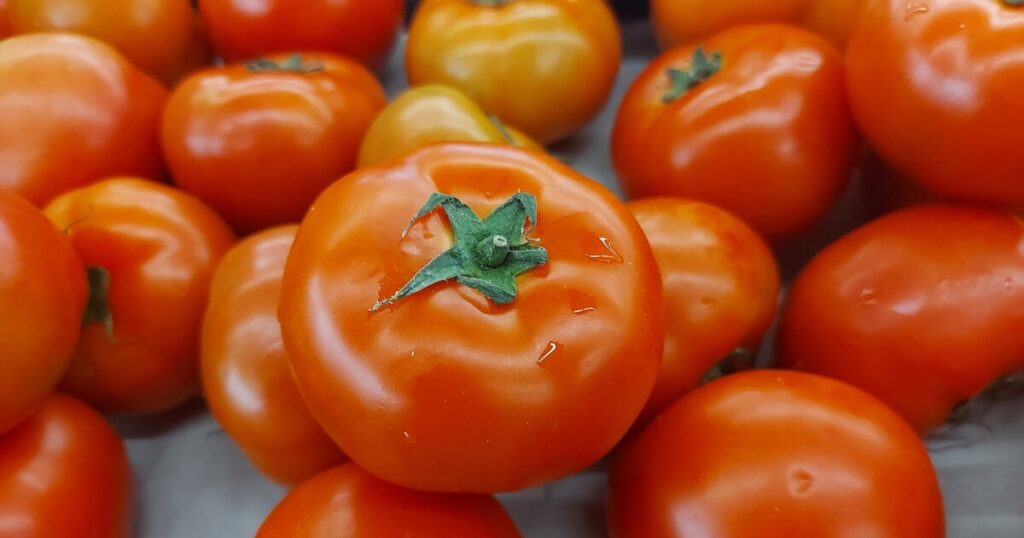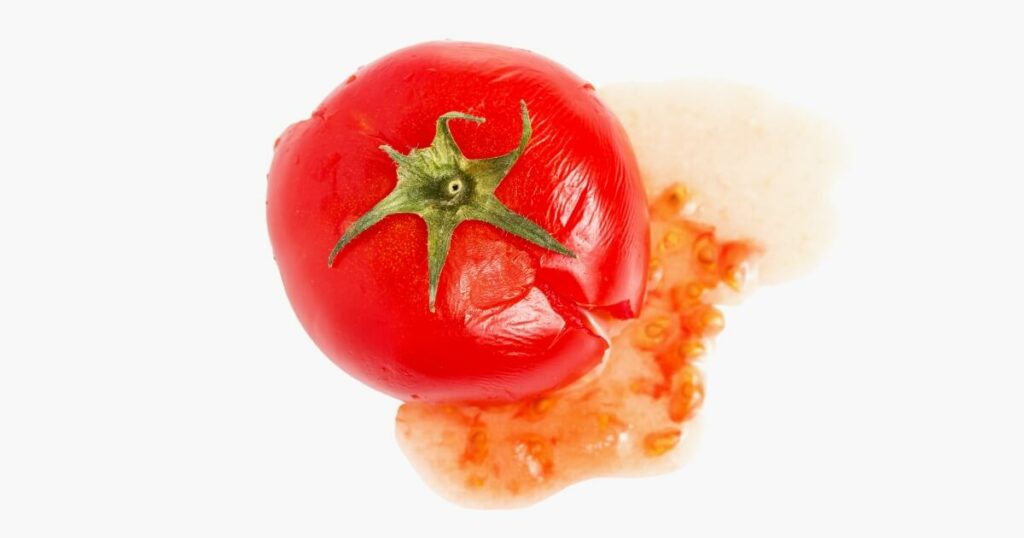Have you ever found yourself with a bunch of tomatoes and wondered how long they’ll stay fresh? Do tomatoes go bad?
Well, whether ripe or unripe, tomatoes have a certain shelf life that depends on how you store them.

In this guide, we’ll look at the shelf life of tomatoes, from juicy heirloom varieties to the petite cherry tomato.
How Long Are Tomatoes Good For?
Fresh tomatoes, with their vibrant colors and rich flavors, have varying shelf lives depending on how they’re stored.
Whether you’re dealing with ripe, unripe, or even canned tomatoes, knowing their shelf life can help you enjoy them at their best.
To make things simpler, I’ve put together a handy table for you.
| Storage Method | Shelf Life | Short Note |
|---|---|---|
| Room Temperature | Up to 7 days | Best for unripe tomatoes. Keep away from sunlight. |
| Refrigerator (ripe) | 5-7 days | Only for fully ripe tomatoes. Avoid long storage. |
| Refrigerator (overripe) | 1-2 days | Use quickly to prevent further deterioration. |
| Freezer | Up to 6 months | Suitable for cooked dishes as texture changes. |
| Sliced (Refrigerator) | 1-3 days | Store in an airtight container. Use quickly. |
| Unripe (Paper Bag) | Varies | Speeds up ripening. Check daily. |
| Canned (Unopened) | 12-18 months | Store in a cool, dry place. Check expiration date. |
| Canned (Opened) | 5-7 days in the refrigerator | Transfer to an airtight container. Keep refrigerated. |
After mastering tomatoes’ shelf life, you might wonder how to spot a tomato that’s past its prime. Check out my other article, “How to tell if tomatoes are bad,” where I explain the telltale signs of a tomato that’s seen better days.
In The Fridge
I often toss my ripe tomatoes straight into the fridge, thinking it’s their best spot. It turns out that ripe tomatoes can hang out in the refrigerator for about 5-7 days. But if they’re already overripe, you’ve got a shorter window at just 1-2 days at most.
And those tiny grape and cherry tomatoes? They’re a bit more delicate, so they might not last as long.
Popping those tomatoes in an air-tight container with a snug lid can help keep them fresh and shield them from excess moisture. If you notice moisture building up, add a paper towel to help absorb it.

But this is a big one: keep them away from onions or apples in the fridge. I learned the hard way that these foods give off gases that can make tomatoes ripen faster.
Refrigerated tomatoes shouldn’t be hanging out in the super cold spots of the fridge because they’ll lose their lovely, sweet flavor.
And you should always keep an eye on your tomatoes. If you spot one going bad or showing dark spots, get it out of there! One bad tomato can spoil the rest.
Left Out At Room Temperature
When it comes to tomatoes, I’ve found that leaving them out at room temperature is often the way to go. Your regular tomatoes, if they’re not fully ripe, can comfortably sit on your counter for up to a week.
Have you ever noticed how a tomato left out seems to have a richer flavor? That’s because room temperature allows tomatoes to retain their sweet flavor compounds. But, over time, they might get a bit softer in texture, especially if they’re exposed to direct sunlight.
Place your tomatoes stem-side down on a flat surface for the best results. This little trick helps prevent moisture loss from the spot where they were attached to the plant.
And if you can, keep them in a single layer for better air circulation. A cool, dry place away from direct sunlight is their happy spot.

Don’t pile them up in a deep bowl or basket. It might look pretty, but the ones at the bottom can get squished.
And steer clear of plastic bags because they trap moisture and can make your tomatoes go bad faster.
And, of course, you need to be on the lookout for any signs of rot or mold, especially if the weather’s been particularly warm.
Tomatoes are natural products, after all, and they can be affected by too much heat or humidity. If one starts to ripen quickly or go south, it’s best to use it up quickly or toss it in the trash to save the others.
In The Freezer
Freezing tomatoes? Yep, I’ve done it, especially when I’ve had a bumper crop from homegrown tomatoes in the garden or went a little overboard at the farmer’s market.
Tomatoes can chill in the freezer for a good 6 months.
One of the great things about freezing is that it’s like hitting the pause button on your tomatoes. It locks in their freshness, making them perfect for sauces or stews down the road.

But remember, once they thaw, they’ll be mushy, so they’re best used in cooked dishes.
Now, if you’re going to freeze them, do it right. Wash and dry your tomatoes first. For larger ones, I like to core and quarter them.
Cherry and grape tomatoes? Just pop them in as they are. Spread them out on a baking sheet to pre-freeze, then transfer them to heavy-duty freezer bags or air-tight containers. This way, they won’t stick together, and you can grab just the amount you need.
And here’s some food for thought: freezing doesn’t just preserve the taste but also retains most of the nutritional value. Sure, there might be a slight dip in some vitamins, but overall, your frozen tomatoes will still pack a punch in the nutrition department.
So, the next time you’re staring at a mountain of tomatoes and wondering how to keep them fresh, remember the freezer’s got your back.
What Affects The Shelf Life Of Tomatoes
Tomato Condition
You know, tomatoes are a bit like people. They come in all shapes, sizes, and conditions. The state of your tomato when you bring it home plays a huge role in how long it’ll last.
A fresh, firm tomato straight off the vine or from the store has a good stretch of days ahead of it. But if it’s got a few blemishes or soft spots? Well, its days are numbered.
If you’ve got an overripe tomato or are showing signs of nearing spoilage, don’t toss it just yet. I’ve been there, and sometimes, these tomatoes are perfect for making a quick sauce. Their flavors are often more concentrated, giving your dishes an extra kick.
In the end, it’s all about being attentive and knowing when to use them, store them, or, sadly, say goodbye to that tomato.
Handling Your Tomatoes
Tomatoes are a bit delicate. They bruise easily, especially those juicy tomatoes or heirloom types of tomato varieties.

Just a little rough handling, and you might end up with a squished tomato in your grocery bag or on your kitchen counter.
Think about their journey for a moment. They have traveled from the farm, maybe spent some time at a farmer’s market or grocery store, and then finally made their way to your kitchen.
Each step of the way, they’re vulnerable to bumps, drops, and all sorts of rough handling. And every little bruise or nick can affect their freshness and taste.
So, here’s a piece of advice from someone who’s had her share of tomato mishaps: treat them like the treasures they are.
- When you’re picking them out, be gentle.
- When you’re transporting them, give them a cushy spot in your bag.
- And when you’re storing them at home, make sure they have enough space and aren’t squished under other produce.
When you bite into a perfectly ripe, unbruised tomato, you’ll know all that gentle handling was worth it.
Storage Temperature
I’ve found that tomatoes thrive best at room temperature, ideally between 55°F to 70°F. That’s their sweet spot, especially if they’re still in the ripening process.
Your fridge does slow down the decomposition process, no doubt about it. Cold temperatures put the brakes on those enzymes that cause green tomatoes to ripen and eventually spoil.
But if you toss them in the fridge too early, especially when they’re not fully ripe, you risk robbing them of their full flavor potential. Cold can mute the vibrant taste of a tomato, and once that’s gone, there’s no getting it back.
Tomatoes love a bit of moisture, but too much moisture loss can be their downfall. That’s why, if you’re storing them in the fridge, keeping them away from the crisper drawer is a good idea, which can trap humidity.
On the flip side, if the air’s too dry, your tomatoes can shrivel up and lose their juiciness.
With the right balance, you’ll keep those tomatoes tasting fresh and fabulous for days to come.
Tomato Shelf Life FAQs
Are you supposed to refrigerate tomatoes?
Not always. Tomatoes are best kept at room temperature until they’re fully ripe. You can refrigerate them to extend freshness, but remember, cold can affect their flavor.
Should tomatoes be refrigerated after cutting?
Yes, after cutting, tomatoes should be refrigerated. Exposed flesh can attract and promote the growth of bacteria at room temperature. Store them in an air-tight container to keep them fresh.
How long can cut tomatoes sit out?
Cut tomatoes should be consumed or refrigerated within two hours. After two hours is the time the USDA says that food becomes unsafe. Leaving them out longer can lead to food poisoning. Always prioritize safety and freshness when it comes to food.











